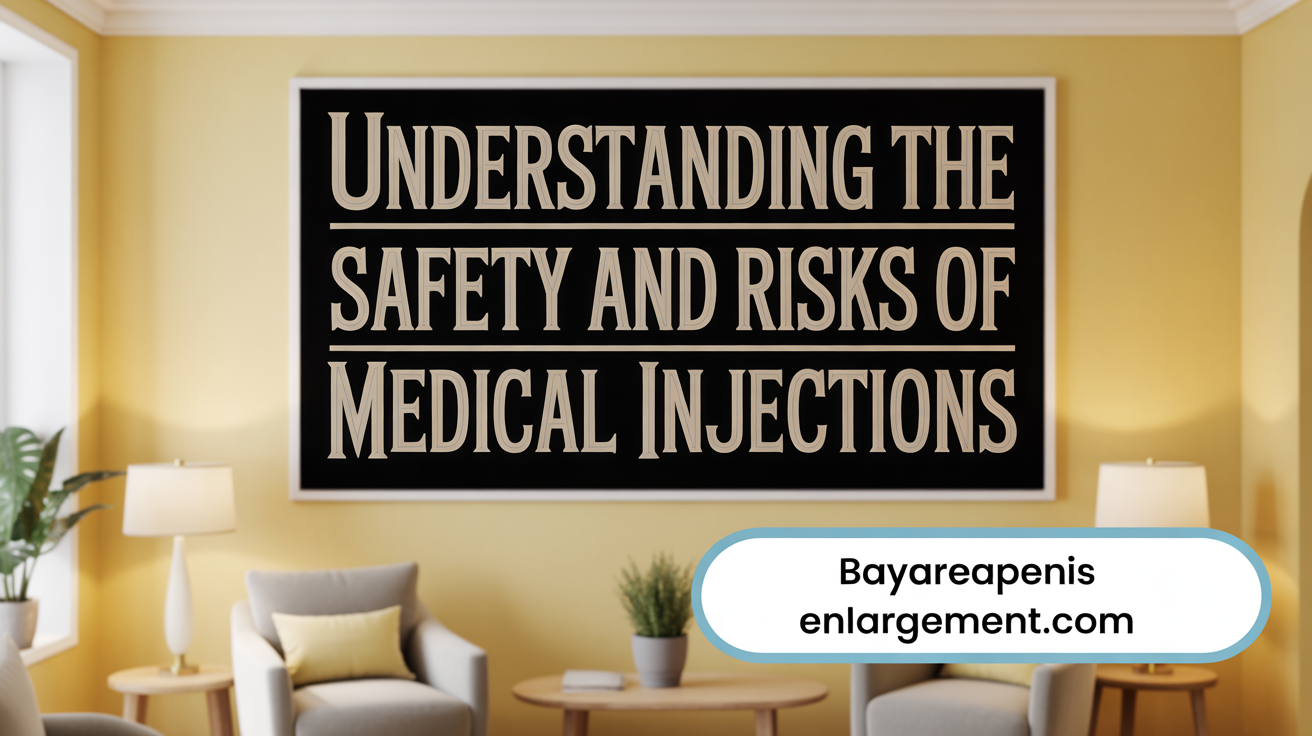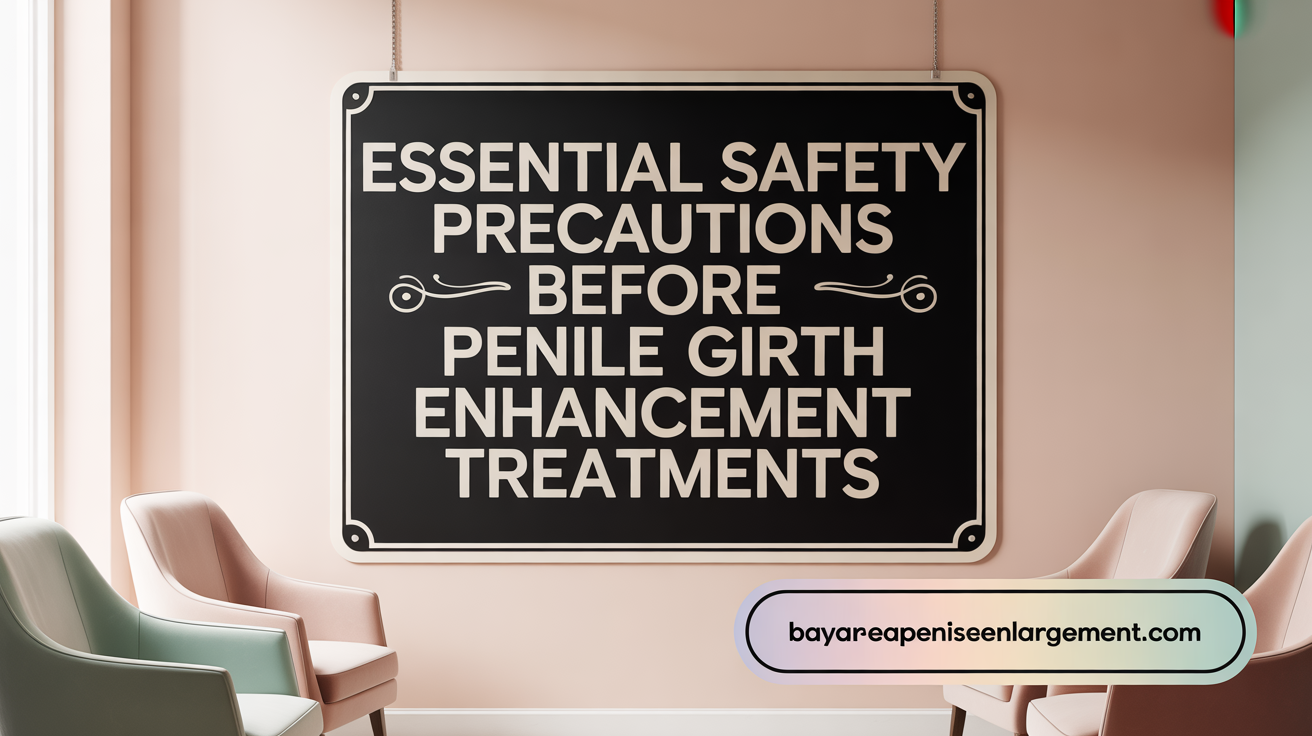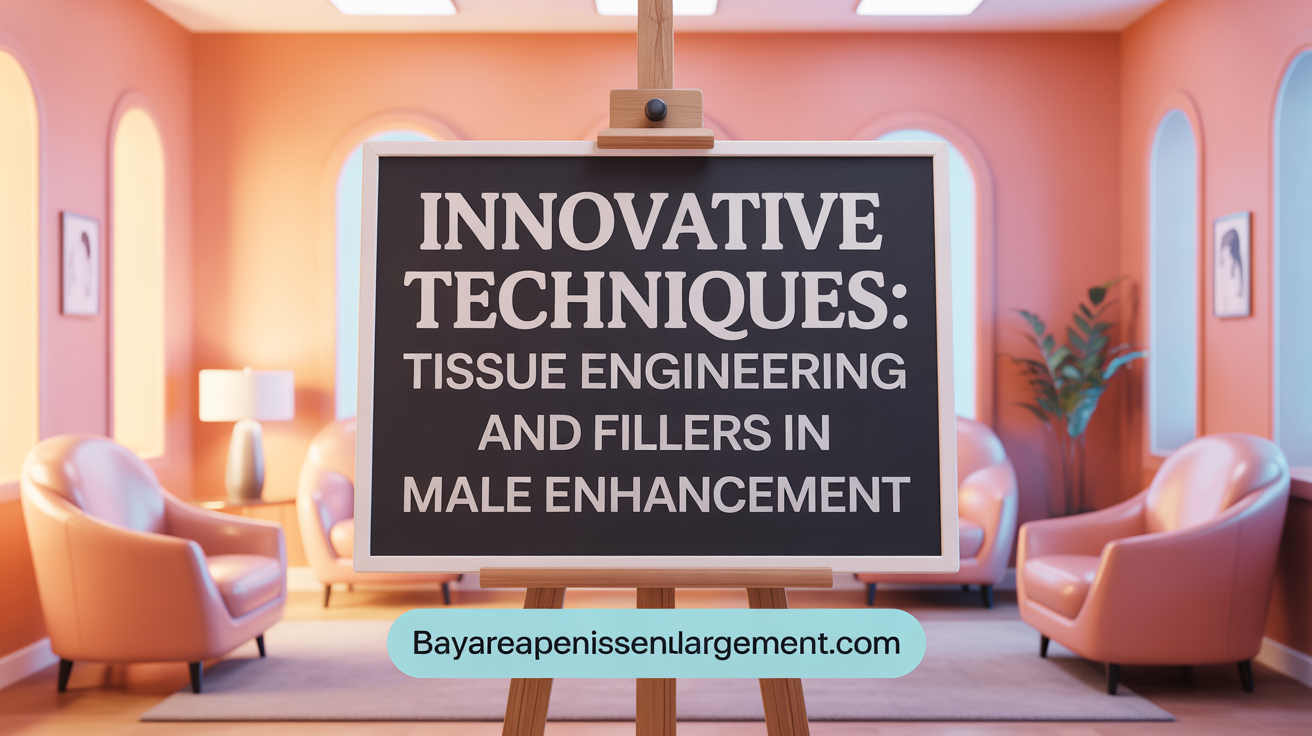Overview of Penile Girth Treatments and Safety Imperatives
Penile girth enhancement procedures have garnered significant attention from men seeking aesthetic and functional improvements. With advancements in both surgical and minimally invasive techniques, a variety of options are now available. However, these procedures carry safety considerations, especially concerning scarring and potential complications. This article provides an in-depth exploration of the safety profiles, risks, and postoperative protocols associated with penile girth treatments, drawing from current clinical insights and evidence-based research to guide patients and practitioners towards informed decision-making.
Safe Approaches to Penile Girth Enhancement

Is there a safe way to increase penile girth?
Yes, there are careful, minimally invasive methods to increase penile girth that can be performed safely by qualified medical practitioners. One common approach involves the use of dermal fillers containing hyaluronic acid, a substance naturally found in the body. These fillers are injected into the shaft of the penis by a trained professional to add volume.
The results are immediate, with most men experiencing an increase in girth of about 0.5 to 1 inch. The effects usually last between 6 to 18 months, depending on the type of filler used and individual factors.
This procedure is generally considered safe when performed by experienced clinicians who adhere to proper injection techniques. It involves minimal downtime, often allowing men to resume normal activities quickly. Importantly, these fillers do not affect erectile function or sensation.
There are also advanced techniques like UroFill™ and GirthPro, which utilize FDA-approved hyaluronic acid fillers and specialized methods to enhance safety and achieve more predictable results. These treatments are designed to provide a reversible and controlled enhancement of girth.
However, before proceeding, it is crucial to consult with a reputable healthcare professional. They will evaluate individual needs, explain potential risks, and help set realistic expectations. Proper training and technique play vital roles in minimizing complications such as uneven swelling, asymmetry, or inflammation.
In summary, safe minimally invasive penile girth enhancement is possible with medically approved procedures administered by qualified practitioners. These approaches offer effective results while prioritizing patient safety.
Safety Profiles and Risks of Penile Injection Therapies

How safe are penile injections for girth enhancement and erectile dysfunction?
Penile injections for girth enhancement and erectile dysfunction (ED) are generally considered safe when performed by a trained healthcare professional. These injections typically include medications like alprostadil, papaverine, or a combination known as Tri-Mix, which are injected directly into the corpora cavernosa.
Proper technique is crucial to ensure safety and minimize risks. Healthcare providers are trained to inject at specific sites and apply appropriate pressure, reducing the likelihood of blood vessel puncture, bleeding, or infections. When done correctly, complications such as pain, bruising, or swelling are usually mild and temporary.
However, some potential adverse effects include the development of scar tissue or nodules that can cause penile curvature or deformity, especially with repeated injections. Rarely, scar tissue buildup can lead to Peyronie's disease, a painful curve caused by fibrous scar formation in the erectile tissue.
The risks of serious damage, such as tissue necrosis or lasting deformity, are low but can occur if injections are performed improperly or too frequently. Overuse of injections may increase the probability of scar formation, resulting in challenging cases of fibrosis.
Infection is a very rare yet possible complication, especially if sterile techniques are not followed. Therefore, strict adherence to hygiene protocols and proper training is essential.
Overall, when administered with proper technique, regular medical supervision, and adherence to recommended injection schedules and site variation, penile injections serve as a safe and effective method for both ED management and girth enhancement. Patients should always consult qualified professionals and undergo thorough training before self-injection to prevent complications.
Regular follow-up appointments help monitor penile health, identify early signs of adverse effects like scarring or curvature, and adjust treatment plans as necessary. If persistent or abnormal erections, pain, or signs of scarring appear, seeking prompt medical advice is crucial to address potential complications early.
Common Side Effects and Risks Across Enhancement Procedures

What are the common side effects and risks of penile girth enhancement procedures?
Penile enhancement procedures, whether surgical or non-surgical, carry a range of potential side effects and risks. Most patients experience mild and temporary issues such as swelling, bruising, and local pain following the treatments.
Swelling and bruising are typical after injections like hyaluronic acid (HA) fillers or platelet-rich plasma (PRP) therapy. These symptoms usually subside within days as the tissues recover. Mild discomfort at the treatment site is also common, especially in surgical procedures or extensive injections.
Scarring and adverse tissue reactions are possible complications, particularly when improper injection techniques are used or if post-procedure care is neglected. Excessive scarring can sometimes lead to deformities or uneven results, with more serious outcomes like tissue induration or nodules forming.
Different methods have varied risk profiles. For example, PRP therapy involves injecting the patient's own blood components, resulting in minimal adverse tissue reactions and a low risk of allergic response. In contrast, fat grafting or implant-based procedures like Penuma® carry higher risks of scar formation, migration, and rejection.
Temporary changes in sensation may occur, especially if nerves are affected during injections or surgeries. Some men report altered sensitivity or numbness during the healing period, though these issues usually resolve with time.
While infections in these procedures are very rare, they do pose a significant risk if aseptic techniques are not strictly followed, or if post-procedure hygiene is compromised.
Overall, while many of these side effects tend to be mild and transient, the need for further research remains. Large-scale studies are essential to establish standardized protocols, optimize safety profiles, and understand long-term outcomes better.
Most importantly, selecting qualified practitioners and adhering to proper techniques can substantially reduce the likelihood of adverse effects, ensuring safer and more predictable results.
Critical Safety Precautions for Patients Considering Penile Girth Enhancement

What important safety precautions should patients consider when deciding on penile girth enhancement?
Patients contemplating penile girth enhancement should begin by selecting qualified and experienced medical professionals. Seeking treatment from board-certified urologists or specialists ensures adherence to safety standards and proper technique, reducing the risk of complications like scarring, infection, or deformities.
Understanding the specific risks associated with each procedure is crucial. While procedures like hyaluronic acid (HA) fillers have a high safety profile when performed correctly, other methods—such as silicone implants or bovine grafts—carry higher risks of rejection, infection, and long-term complications.
Patients should set realistic expectations about the results. Typically, procedures yield modest increases in girth, averaging about 1 to 2 centimeters, and individual outcomes can vary based on anatomy, technique, and adherence to postoperative care.
Proper pre- and post-procedure care plays a vital role in safety. Patients must follow hygiene protocols, avoid strenuous activity during recovery, and attend scheduled follow-up visits to detect and address any issues early.
Ensuring thorough informed consent is vital. Discussing all potential risks, benefits, and alternatives with the treating physician helps patients make well-informed decisions. In some cases, a psychological or mental health evaluation may be recommended to confirm that the desire for enhancement aligns with realistic outcomes and emotional well-being.
Overall, prioritizing education, choosing reputable clinics, and adhering to medical guidance can significantly mitigate risks and contribute to satisfactory and safe treatment results.
Advanced Techniques: Tissue Engineering and Injectable Fillers in Penile Augmentation

What are the safety considerations and potential complications associated with penile augmentation techniques such as tissue engineering and injectable fillers?
Penile augmentation methods, including tissue engineering and the use of injectable fillers, have become areas of active development with promising safety profiles. Injectable fillers like hyaluronic acid (HA) and polylactic acid (PLA) are minimally invasive options that typically involve low risks. Patients usually experience mild adverse effects such as inflammation, transient pain, or small nodules at the injection site, which tend to resolve without complex intervention.
However, improper technique or incorrect site selection can lead to irregularities, inflammation, or even infections. In rare cases, improper injections might cause asymmetry or lump formation. Nonetheless, these complications are generally manageable and less common when performed by trained professionals.
More invasive procedures, such as tissue engineering with biodegradable scaffolds, involve harvesting autologous cells and placing them in scaffolds before implantation. This approach aims to stimulate natural tissue growth with fewer complications. Early clinical evaluations suggest these methods have a low rate of adverse effects, primarily limited to minor infections or localized necrosis if strict sterile protocols are not followed.
In surgical and invasive procedures, risks include infection, scarring, penile deformities, loss of sensation, and, in some cases, urethral issues like strictures or fistulas. Proper patient selection, surgical expertise, and adherence to sterile techniques are crucial elements to minimize these risks.
Overall, safety in penile augmentation depends heavily on the choice of method, the practitioner's experience, and comprehensive patient counseling. It is vital to conduct thorough preoperative assessments and establish realistic expectations to ensure patient safety and optimal outcomes.
Postoperative Protocols and Complication Management Strategies
What postoperative safety protocols and complication management strategies are important after penile girth enhancement procedures?
After penile enhancement procedures, careful postoperative care is vital to prevent and manage complications. The main focus should be on vigilant monitoring for issues such as infections, hematomas, tissue necrosis, and swelling.
Wound care and maintaining proper hygiene are essential to minimize infection risks. Patients are typically advised to keep the injection or surgical area clean and dry, and to avoid activities that could disrupt healing. Applying cold packs or ice to the area can help reduce swelling and bruising, while pain management often involves conservative measures or prescribed medications.
Activity restrictions are important. Patients are generally advised to limit strenuous activity, avoid sexual activity, and wear supportive clothing to limit movement that could stress the treatment area. Follow-up appointments enable healthcare providers to monitor progress and intervene early if complications develop.
Handling subcutaneous nodules, which can sometimes occur after filler injections, involves options like hyaluronidase injections to dissolve the filler or surgical excision if necessary. Bleeding and hematoma formation typically resolve on their own, but larger hematomas may require drainage.
Infection prevention is crucial, especially in patients with risk factors such as diabetes. Strict aseptic techniques during the procedure, prophylactic antibiotics, and careful patient selection help reduce infection odds. Recognizing early signs of infection allows prompt treatment, which may include antibiotics or drainage.
Long-term monitoring is essential for detecting late-onset issues such as scarring, deformities, or migration of injected material. Regular check-ups enable timely intervention, preventing permanent damage and ensuring functional and aesthetic satisfaction.
Overall, adherence to proper postoperative protocols and swift management of complications are fundamental to achieving safe and successful outcomes in penile girth enhancement procedures.
Evidence-Based Safety Outcomes and Adverse Effects in Penile Enhancement
What evidence-based information is available regarding the safety outcomes and adverse effects of penile augmentation procedures?
Scientific studies offer a varied picture of the safety profiles associated with different penile enhancement techniques. Minimally invasive procedures, such as hyaluronic acid (HA) fillers, are generally considered safer options with low complication rates, estimated at around 4.3%. Typical mild adverse effects include transient edema, subcutaneous nodules, and minor inflammation, which usually resolve without significant intervention. Serious complications like infections are very rare but can occur, necessitating careful technique and patient selection.
On the other hand, more invasive surgical methods such as penile disassembly, autologous fat transfer, or total phalloplasty are associated with higher risks. These procedures can involve substantial scarring, hematoma formation, fistula development, and postoperative deformities. Recovery times are longer, and adverse effects can sometimes be persistent or severe.
Overall, the current scientific literature affirms that while many penile augmentation procedures are safe when performed by qualified professionals, they are not without risks. Complications such as scarring, nerve damage, and erectile dysfunction, although infrequent, highlight the importance of comprehensive preoperative assessment and counseling.
Limitations in existing research are notable. Many studies are observational, with small sample sizes and heterogeneous methodologies, limiting generalizability. Long-term safety data and patient satisfaction metrics are often lacking or inconsistent. Consequently, there is a critical need for well-designed, large-scale clinical trials that evaluate both short-term and long-term outcomes.
Future research should aim to standardize procedures, improve risk stratification, and develop guidelines to optimize safety. Patients considering penile enhancement must be counseled thoroughly about the potential adverse effects and the current limitations of scientific evidence, ensuring informed decision-making.
Surgical Techniques and Their Safety Considerations
Autologous fat transfer, grafts, and Alloderm use
Surgical penile augmentation often involves procedures such as autologous fat transfer, where fat from other parts of the body is injected into the penis to increase girth. Grafts made of dermal tissue or Alloderm, a tissue matrix derived from donated skin, are also used to enhance size permanently. These methods can provide satisfactory results but require precise technique to avoid complications.
Risks of scarring, infection, and loss of sensation
All surgical enhancements carry potential risks. Scarring is a concern, particularly if improper techniques are used, leading to deformities or palpable nodules. Infection, although rare, remains a serious risk that may necessitate further intervention. Additionally, there is a possibility of decreased sensation or nerve damage, which can affect sexual function.
Complex procedures: penile disassembly and total phalloplasty
More complex surgeries, like penile disassembly or total phalloplasty, are typically reserved for severe cases such as micropenis or traumatic injuries. These procedures are intricate, involving the dissection and reconstruction of penile tissues, and carry significant risks including flap necrosis, urethral fistulas, and prolonged recovery periods.
Importance of surgeon expertise and patient screening
Due to the complexity and potential complications, selecting a highly experienced, certified surgeon is essential. Proper patient screening, including detailed preoperative assessment and realistic outcome expectations, helps minimize risks. Surgeons must evaluate individual anatomy and health history to determine the safest, most suitable approach.
Functional and aesthetic balance in surgery
The goal of penile surgery should balance improved appearance with preservation of function. Patients should understand that surgical success is measured not only by size increase but also by maintaining erectile function, sensation, and overall penile health. Transparent communication and thorough planning are crucial for achieving satisfactory and lasting results.
Psychological and Ethical Implications of Penile Girth Treatments
Patient dissatisfaction and body image concerns
Many men seeking penile girth enhancement do so due to dissatisfaction with their size, often linked to body image issues. Studies have shown that up to 45% of men report concerns about their penis size, which can significantly impact self-esteem and sexual confidence. It is crucial to recognize that such perceptions may not always align with clinical or aesthetic standards.
Counseling and mental health evaluation
Before considering any intervention, a thorough psychological assessment should be conducted. This helps determine if dissatisfaction stems from underlying body dysmorphic disorder or other mental health conditions. Mental health professionals can provide counseling to address these concerns and ensure that patients have realistic expectations about outcomes.
Ethical cautions against non-standardized procedures
Many penile enhancement options lack robust scientific validation and are often marketed with exaggerated claims. Unstandardized procedures or those performed by unqualified providers can lead to serious complications, including scarring, deformity, or loss of function. Medical practitioners should adhere to established safety protocols and avoid offering unproven treatments.
Role of multidisciplinary teams in treatment planning
An optimal treatment plan often involves a team, including urologists, mental health professionals, and qualified cosmetic surgeons. This collaborative approach ensures comprehensive care, addressing both physical concerns and psychological well-being, and helps in making informed choices.
Promoting realistic expectations and informed consent
Effective patient education is vital. Healthcare providers should communicate the realistic results, potential risks, and the limitations of all available procedures. Informed consent involves explaining the uncertainties and possible complications, empowering patients to make decisions aligned with their values and health priorities.
| Aspect | Key Points | Additional Details |
|---|---|---|
| Concerns Addressed | Dissatisfaction, body image | Emphasize psychological roots and need for evaluation |
| Approach | Counseling, mental health | Identify underlying issues and set realistic goals |
| Ethical Practice | Use of validated techniques | Discourage unproven or unsafe procedures |
| Team Dynamics | Multidisciplinary involvement | Combine physical and psychological care |
| Patient Education | Clear communication | Set realistic expectations, emphasize consent |
Balancing Innovation and Safety in Penile Girth Enhancement
Penile girth enhancement offers promising options ranging from minimally invasive fillers to advanced surgical and tissue engineering techniques. Nonetheless, potential risks—particularly scarring, infection, and functional complications—remain critical considerations. Evidence supports that procedures conducted by qualified specialists using proper protocols have improved safety profiles and patient satisfaction, yet no method is without risk. Patients must be thoroughly counseled, carefully selected, and monitored with realistic expectations emphasized. Continued research and standardization are essential to optimize outcomes and minimize adverse effects. Ultimately, a thoughtful, multidisciplinary approach that prioritizes patient safety and psychological well-being is paramount in advancing penile girth treatments.
References
- Penile Injections: A Patient Guide - UCSF Health
- Penile Girth Enhancement - Comprehensive Urology
- Is Girth Enlargement Safe? - The Perito Clinic
- Understanding Penile Enlargement: Options, Safety, and the ...
- Techniques for Penile Augmentation Surgery: A Systematic Review ...
- Complications of Genital Enlargement Surgery - Oxford Academic
- Efficacy and Safety of Penile Girth Enhancement Using Hyaluronic ...
- A Critical Analysis of Penile Enhancement Procedures for Patients ...

